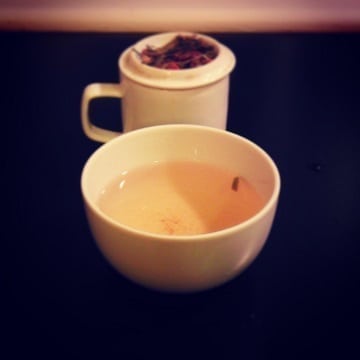
2012 can suck it.
Okay, perhaps I should elaborate. Since about – oh – 2008, I can’t say I’ve had a particularly “good” year, by any stretch. They’ve usually been a mish-mash of good and bad. The finest example of this was 2010, which was just…bipolar. 2012, however, was just all-around shite right out of the starting gate. So bad, in fact, that I took an (unintentional) hiatus from anything to do with writing for the better part of December. I had nothing positive to impart, and – frankly – didn’t feel like rehashing my dark mood.
As a result, for this entry, I’m going to focus on the (few but far between) positive moments of the last year. Over the summer – like I’ve said in prior entries – I decided to “retire” from tea reviewing. My heart (and time) weren’t into it anymore. I was also under the delusion of focusing on other projects. That didn’t quite pan out, but – honestly – was anyone really surprised?
One of the things I was looking forward to was finally whittling down my vast tea stores. Without an influx of new teas coming in, perhaps I could finally notch them off – one cup at a time. That didn’t quite pan out, either. Reason being? The kindness of strangers. I may have given up on tea reviewing…but it didn’t give up on me.
I would like to highlight and wax awesomely about some of these kind folks:
The Photo-Biker Tea Shaman
If – by the grace of Brahma – I ever make it to Darjeeling in my lifetime, the first person I’m looking up is Benoy Thapa of Thunderbolt Tea. Back in ’08, when I first started writing about tea, I received a random Facebook friend request from him. It took me to several months to do “the maths” to figure out that he was the headliner of Thunderbolt. The following year, he sent along a care-package of teas to review and a few other goodies.

He is solely responsible for my complete 180° opinion change about Darjeeling teas. In 2012, he came through again with some exquisite teas from Turzum, Risheehat, and Castleton. I wrote about each and every one of them, and I still pull the packs out for reflection. Benoy is probably the nicest tea-guy I’ve ever met, and I hope one day to shake his hand. And buy all of his tea. All of it.
Tea MC Tiff
There was a time in the middle of the year when I made regular tea pit stops to my favorite brick-‘n-mortar stores. On Saturdays, I usually made runs to The Jasmine Pearl. On Mondays, I could be found at Smith Teamaker. For the latter, I usually went in the morning before the rush started.
Tiffany was often the host on duty, and gracefully put up with my esoteric tea-fueled diatribes for the two hours I was there. She also made a mean bowl of matcha. Aside from the bowl, I usually left the place about two pots in.
On one such outing, she informed me that she and her son were planning a trip to Japan. She asked if I knew of any tea gardens that were near Kyoto. I racked my brain for a bit while sipping, then it hit me. Obubu! (I love that name.)

I gave her the info on how to contact the garden for a tour. The following week, she told me that her contact form hadn’t been approved yet, nor had she received a reply about it. I took to Twitter to contact their main sales-guy directly. He replied mere seconds later and sped up the process.
Tea MC Tiff ended up visiting the plantation and had a wonderful time. That and she brought back some teas (plural) from her trip. Chief among them, some Hawaiian green and sakura blossoms – the latter of which had been on my Tea WANT! list forever. It took me forever to try it, but I’m thankful for the opportunity.
It really is who ya know.
The Purrfect Cup
Courtney Powers (great spy name, by the way) is my girl-bro. I say that because I can’t think of any other gal that has had my back in 2012 like this sister-blogger. She encouraged me if/when I was ever down, she was the perfect NaNoWriMo cheerleader (which I never completed), and the best part…
She sent me some damn good tea.

Thanks to her, I was finally able to try some of the wares from Verdant Tea, a company that I’d been eyeing for several months. Their Zhu Rong and Laoshan series were topnotch. And I wouldn’t have been able to say that if it weren’t for her “purrfect powers”.
The SororiTea Sister
The funny thing about this fellow tea reviewer – alias, LiberTeas – is that she’s practically a neighbor. I’ve never met her – probably never will – but some of the best teas I tried this year stemmed from her. Steepster’s to blame. I saw an update on that tea social media site regarding a Darjeeling white I’d never tried from my favorite estate – Giddapahar.

I left only one comment on the actual SororiTea Sisters review. I think it said, “WANT!”
A couple of months later, I received a package from her with that Darjeeling white, and a few others she thought I’d enjoy. Prior to that, we had made a few tea swaps, and almost always, they had been unsolicited. She’s just that nice. I still have quite a few of those samples to pound through, too.
The Powers That Be
Along with insanely good blogging tools and advice, the Davenport duo that run this here site have also shown great tea patronage. This year, Jackie imparted some offerings from the Doke estate – the one managed by the Lochan family. One was an oolong; one was a white. Both were exquisite.

I had plans to include them in an epic story, but that never came to pass – alas. But I’m still grateful to have had the opportunity to sip them. Copiously.
Big Brass Butiki-s
As I’ve mentioned before, Stacy Lim – the purveyor of Butiki Teas – is on my palate wavelength. She has a flare for the unusual, a leaning I can relate to and respect. She sent me an e-mail some months ago wondering if I’d ever heard of Japanese pu-erh. I rattled off some things I had tried, yet she said those weren’t what she was thinking of.

Before I could apologize for not being more useful…she offered some up for sampling. A month or two later – barring hurricane delays – I received an ample package containing a sample of the aforementioned pu-erh and a few others. Of the nine, I’ve unfortunately only made it to two. With tea patronage like this, delays are inevitable. I couldn’t thank her enough.
“The Hero of Canton”
Back in the spring, I was “commissioned” by Canton Tea Co. for a guest blog on a couple of new Dan Congs they were putting on the market. Unfortunately, being well…uh…me, I didn’t finish the guest blog until that summer. I received an e-mail back from their sales lead stating that they had other plans for the blog. They were about ready to launch a new weekly tea club, and they wanted me to be a VIP.
What this meant exactly, I had no clue. I thought it consisted of a couple of samples as payment for the guest blog, and that was it. Boy, was I wrong.

It’s been twelve (or so?) weeks since the official Canton Tea Club launch, and I’m still a member. I get new and unique teas once per week. They have yet to call upon me to do another write-up, but the teas keep a-comin’. I’m starting to wonder if it’s a clerical error, or if they’re seriously just that cool. For now, I’ll go with the latter and not question it.
I “heart” them dearly. And, seriously, their tea club is a game changer. You – fair reader(s?) – should check it out.
The Great Wizard Zendalf
Also in the spring, I received a DM over Twitter from Zen Tara requesting to send me some Darjeeling to review. This was prior to my “retirement”, so I naturally said, “Hell yeah!”
Time went by, though, and I never saw a package. I didn’t press them on it because – well – that’d be douche-y. What would I have said, “Hey, where’s mah free tea?!”
Uh…no.

I let it slide, and forgot about it over the passage of time. Literally a week before Christmas, I received a rather large box in the mail. Five teas were contained in said box with a letter from “The Great Wizard Zendalf”. It told an epic story of how this delivery came to be, and instantly earned my approval of awesomeness. Among the teas in the package was a note-perfect golden-tipped Assam from the Khongea estate that I’ll be reflecting on at a later juncture. Still, what a way to make an entrance, Zen Tara. You know me too well.
Clouds and Mist
This wouldn’t be a true gratitude blog if I didn’t mention tea authoress, Jo Johnson. On top of being one of my biggest cheerleaders from the get-go, she also mentioned that I’m in the forward of her upcoming book. That alone caused more warm-fuzzies than any other moment this year.
A couple of weeks back I received a Christmas card and a sample packet of tea. It was a Cloud & Mist green, a type I’m not usually a fan of. However, I brewed it up anyway.
Not sure if it was the tea, my gratitude, or a bunch of other factors…but it was the best green I’d tried.
And I think that pretty much sums the good things from this year.
2012 can suck it
But I will still sip it.














































